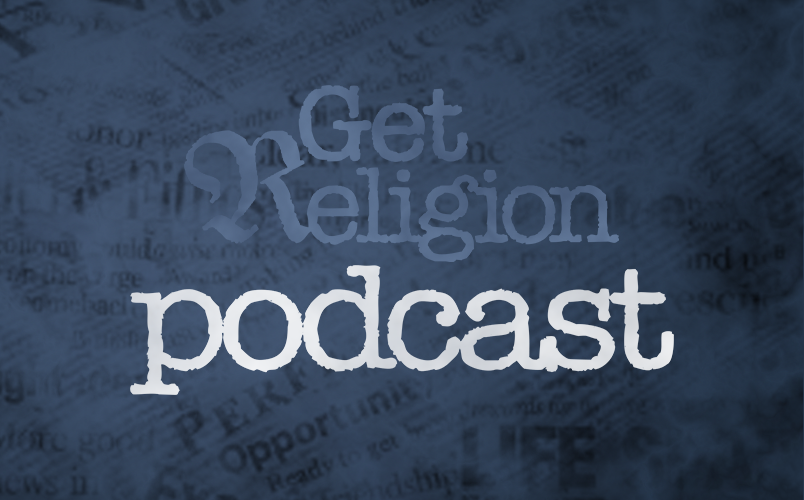Stop and ask yourself the following journalism puzzler (I apologize for the length of this thing).
Why did the Covington Catholic High School “smirk” incident with Native American elder Nathan Phillips seize the American media and even cause waves overseas, while the effort by Phillips and his drummers to march into and interrupt a Mass at the National Shrine of the Basilica of the Immaculate Conception (security personnel stopped them) drew a radically mainstream media response (something like this, click here)?
The answer is clear: The gatekeepers in key, elite newsrooms thought the first story was big news and the second one was not.
But why did they feel that way? Why ignore one story and carpet-bomb the other?
That gets us into the media-bias minefield that I have been exploring my entire professional career, starting in the late 1970s and early 1980s (click here for my 1983 cover story for The Quill, a professional journal). But that answer only raises more questions: Why do so many journalists ignore, downplay or even mangle religion stories? What kind of bias is involved? As for that topic, click here for my second cover story at The Quill, in 1993. There is no one bias linked all this — there are four of them.
Welcome to this week’s “Crossroads” podcast, which — #DUH — returns to the Covington Catholic story. Click here to tune that in.
I want to point readers to a new mini-essay by one of my favorite writers, David French of National Review. He is a Harvard Law School graduate who specializes in religious liberty cases. As an outspoken #NeverTrump #NeverHillary conservative, he has been caught in the middle of many media flash fires in recent years.
The headline on this piece: “We’re Plagued by a Partisan Press. Here’s One Cure.” It focuses on the lack of intellectual and cultural diversity in many newsrooms. This reality affects decisions about what is and what is not news.
But before we get to French, let me remind readers of the following language in the amazing 2005 self-study conducted by the New York Times, during a time of turmoil over journalism ethics. The title: “Preserving Our Readers’ Trust.”
Our paper’s commitment to a diversity of gender, race and ethnicity is nonnegotiable. We should pursue the same diversity in other dimensions of life, and for the same reason — to ensure that a broad range of viewpoints is at the table when we decide what to write about and how to present it.
The executive editor should assign this goal to everyone who has a hand in recruiting. We should take pains to create a climate in which staff members feel free to propose or criticize coverage from vantage points that lie outside the perceived newsroom consensus (liberal/conservative, religious/secular, urban/suburban/rural, elitist/white collar/blue collar).
A few pages paragraphs later, there is this:
In part because the Times’s editorial page is clearly liberal, the news pages do need to make more effort not to seem monolithic. Both inside and outside the paper, some people feel that we are missing stories because our staff lacks diversity in viewpoints, intellectual grounding and individual backgrounds. We should look for all manner of diversity. We should seek talented journalists who happen to have military experience, who know rural America first hand, who are at home in different faiths.
Religion news keeps popping up, in this study, as an example of a topic the Times was struggling to cover in an accurate, fair and balanced manner.
It is interesting to note that this call for intellectual and cultural diversity in hiring was the only crucial point in the self-study that executive editor Bill Keller fudged on accepting, in his written response. Keller believed that his staff could just try harder and, with some additional training, get the job done. (Keller is a name well known to GetReligion readers.)
That brings us to French. You really need to read the whole piece, but he sees three crucial factors that affected coverage of the Covington Catholic story and many others like it.
Hold that thought. French states:
Lots of people acknowledge the failure. Lots of people regret the rush to judgment. Lots of people hope and pray that we can do better next time. And perhaps some will. There are many good journalists who try very hard to get stories right. There are many pundits and commentators who diligently analyze and scrutinize reports in good faith and with a sense of proportion.
But overall? I’m profoundly pessimistic. This will all happen again and again. It’s time to face facts: So long as our nation’s newsrooms are ideological monocultures, not even the best of intentions can block the formation of a partisan press.
First of all, he writes, there is simple ignorance when it comes to the lives of religious people (especially those in traditional flocks). To be blunt: Many reporters know not what they do.
The prime reason that I held off from the initial Covington pile-on was simple. I know the culture of southern high schools, including southern private high schools. I know the culture of teenage boys. I’m raising a teenage son in the South. He’s been in private and public school. I’ve chaperoned two Washington, D.C., class trips. I’ve been surrounded by his friends for years, and I’ve seen the student bodies of countless high schools at sporting events across the state.
And so, while it wasn’t impossible (nothing is impossible) that the initial incriminating tweet was true, I knew that it was extraordinarily unlikely. For me, a group of Kentucky teens wasn’t the hostile “other,” but rather a community I know well. I felt nearly certain that there was another side to this story.
At some level, the modern newsroom gets the value of knowledge and experience when reporting on different American communities. They diligently seek to hire reporters from historically marginalized communities. They do not, however, apply the same diligence to hiring people who come from the intellectual and religious communities on the other side of the great American divide. This creates yawning gaps of ignorance.
Second, reporters in the deep-blue power zones of America’s coastlines tend to have different interests than most people in “flyover” country.
Here’s one example. Get ready, French said, for a tsunami of coverage when “Game of Thrones” ends. Lots of people (French included) watch that show — but it is a cornerstone of life in elite, urbane, sophisticated America. Other differences? Look at zip-code factors linked to faith and family.
Finally, if a person is analyzing media without understanding the role of relationships, they’re doing it wrong. Reporters are human. They make friends. They marry. The build networks. And when they live and work in ideologically sealed environments, all those relationships start to run in the same direction.
This means that when a progressive reporter at a mainstream publication is reporting on a potential Democratic scandal, there is a very good chance that he’ll be reporting on the actions of someone he knows — perhaps even someone he likes. And this isn’t just a Democratic issue. One of the hidden stories of conservative coverage of Trump is the extent to which members of conservative media have the same kind of longstanding personal relationships in the Trump White House that Democratic reporters have with members of a Democratic administration.
I would add this: People on the cultural right continue to pay a high price for decades of contempt shown to the field of journalism, in general. Have many Christian colleges, for example, worked hard to prepare students to work in mainstream media, as opposed to public-relations offices and nonprofit Christian publications?
That’s another topic beach I have bled on for many decades. But there’s no way around that truth.
Here’s a final thought from French:
Unless … the mainstream media are willing to welcome different perspectives — and, by the way, “diversity” is not defined as “people of different races, genders, and religions who all vote alike” — the drift to a purely partisan press will continue, and in a polarized nation, I can think of few things that will divide us more.










